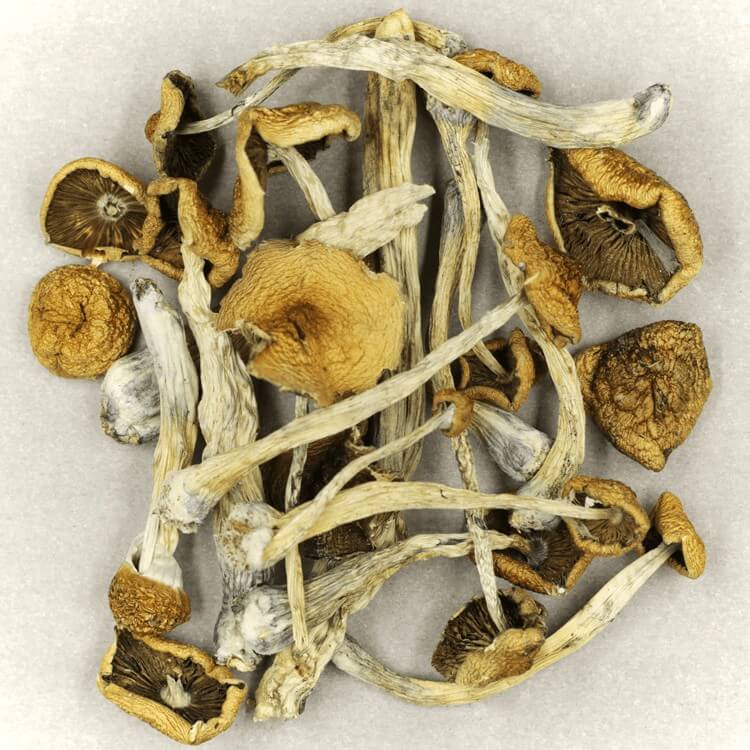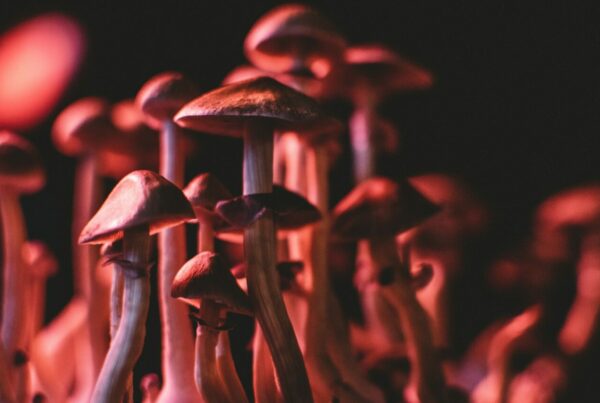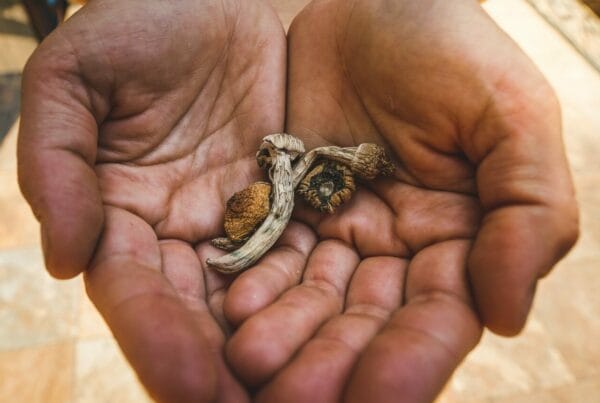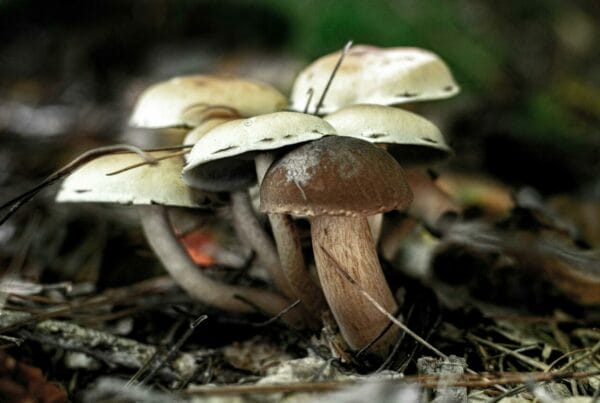Once perceived as wildly potent, the strength of Psilocybe mexicana is now being reassessed in light of new psilocybin research. Continuous discoveries in the field of psychedelic research have highlighted its therapeutic benefits, contributing to its gradual recognition in the medical sphere. This burgeoning field holds great promise for experts who are working tirelessly to determine safe dosage levels for medical applications.
Key Takeaways
- Researchers are using advanced techniques such as liquid chromatography coupled with tandem mass spectrometry to ascertain the potency of mushrooms.
- Psilocybe Mexicana, along with other mushroom varieties, is being studied in clinical trials to discern its potential therapeutic applications.
- The genetic diversity of magic mushrooms is crucial for creating a precise dosage guide.
Psychedelic Mushrooms: A Journey from Obscurity to Scientific Revelation
In the past, only a few conditions were thought to benefit from Psilocybe Cubensis. However, current research on psilocybin is uncovering a plethora of previously unknown medicinal benefits.
Experts are exploring the potential of Psilocybe Mexicana and other potent strains for clinical trials and in-depth research. Whether the research involves in vivo or in vitro subjects, this strain consistently demonstrates the true efficacy and benefits of the fungus species.
Psychedelics on the Threshold of the Market
Once shrouded in mystery, continuous breakthroughs and revelations have sparked a surge of interest in psychedelics, particularly among those seeking therapeutic solutions. Traditional mental health treatments often fail to meet patients’ needs, leading many to explore more effective alternatives.
Enter the world of magic mushrooms.
People struggling with mental health conditions are now turning to psilocybin, which has demonstrated potential in treating issues such as depression, alcohol dependency, anxiety, compulsions, tics, chronic pain, and more.
Currently, medical professionals are developing innovative methods to calculate the ideal dosage for safe patient administration. Notably, a research team from the University of Texas has devised a model for extracting psilocybin and psilocin concentrations.
Establishing the clinical potency of magic mushrooms is now a real possibility.
The Distinctive Attributes of Psilocybe Mexicana
The first technique involves the extraction and quantification of psilocybin and psilocin from dried mushroom samples. This process ensures accurate measurements and helps maintain sample integrity.
The second technique uses an innovative approach to differentiate between various species of magic mushrooms. This method helps researchers understand the unique psychoactive properties of each species, aiding in the development of safe usage guidelines.
These techniques represent progressive steps in psychedelic research, paving the way for new insights and breakthroughs in understanding the therapeutic potential of magic mushrooms.
Conclusion
While Golden Teachers, Blue Meanies, and B-Plus have been the focus of numerous studies, there’s a need to delve into lesser-known species to broaden our comprehension of safe psilocybin mushroom use. The Mexicana species stands out as an excellent choice for research due to its historical significance, consistency in psilocybin levels, and relative low potency.
With the advent of innovative potency testing techniques and a deeper understanding of the unique properties of different species, we are on the brink of unlocking the full therapeutic potential of these intriguing fungi.
- Liquid chromatography is a technique for separating and analyzing chemical compounds in a mixture, such as the active chemicals found in shrooms. The procedure entails passing a liquid sample through a column filled with a solid material, known as the stationary phase. The distinct interactions between the chemical components in the sample and the stationary and mobile phases cause their separation at different speeds as they traverse the column.
- Spectrometry is usually employed to investigate the interaction of matter with electromagnetic radiation at various wavelengths. It identifies and quantifies substances based on the specific wavelengths of light absorbed and scattered by molecules. This enables the determination of the electronic, vibrational, and rotational states of the chemical.
This method was utilized on five strains of magic mushrooms. The researchers found that the average total levels of psilocybin and psilocin among these strains varied from 0.879 to 1.36. These concentrations exceeded those of many other strains, such as Bull Run and Cambodian. The accuracy of their study was confirmed by comparing their findings with data from other independent labs.
The agreement in results between the two labs further reinforced the validity of their testing procedure in accurately determining the potency of the shrooms.
Provided it’s endorsed by experts, this method could supplement existing psychedelic potency testing techniques and act as an extra safety guard against unsafe dosage estimations.
Expanding Research to Include Other Species
Research extension to other species is advantageous. It can deepen our comprehension of the health benefits related to different strains, and provide baseline data about the effects of less potent mushrooms.
Additionally, it can contribute to public education about the influence of various doses on the psychedelic experience. Comparing the Mexicans strain with more potent strains like Psilocybe Cubensis can help scholars understand how different concentrations of active compounds can affect therapeutic results.
For example, the Blue Meanies strain delivers more powerful hallucinogenic effects, which might prove beneficial in treating conditions such as depression. On the other hand, lower potency strains are more suitable for microdosing or milder uses, such as mood enhancement or improving focus.
Genetic Diversity Leads to Safer Treatments
It’s not widely recognized that different cultivars or varieties possess distinctive genetic profiles and
Different hallucinogenic mushrooms have variations in power, chemical construction, and effects. This diversity allows medical experts to select the most suitable type for specific medical purposes and adjust doses according to individual requirements, thus reducing risks and maximizing benefits.
Take, for instance, Psilocybe Semilanceata (Liberty Caps) or Psilocybe cyanescens. They possess unique alkaloid profiles that may be effective in managing anxiety. On the other hand, synthetically grown mushrooms might be better suited for addressing substance addiction or compulsive behaviors. This diversity enables the development of tailored treatments with enhanced safety and efficacy.
From this, we can infer that the genetic diversity in hallucinogenic mushrooms, combined with new techniques for evaluating strength and identification, is vital for the creation of safer medical treatments.
Enhanced Safety in Medical Applications
Let’s contemplate the potential benefits of safer dosage administration.
- Decreased overdosing incidents: Accurate dosing eliminates the fear of overdosing. This also implies the need for clearer product labels to avoid confusing consumers.
- Increased predictability: With more precise dosing, individuals can expect certain effects or experiences during their trips. This can reduce overwhelming sensations and anxiety, leading to greater patient satisfaction.
- Uniform measurement: Accurate dosing can encourage a standardized measurement system, enabling people to easily refer to charts for potential effects.
Experience the Advantages of Accurately-Dosed Shrooms Using Advanced Potency Tests | Buy Magic Mushrooms Online at Schedule35 Canada
If these two pioneering methods continue, you won’t have to deal with unanticipated effects. Combine this with smart online shopping at Schedule35 Canada. We offer dried mushrooms that provide a serene, relaxing psychedelic journey without excessive psychoactivity. Order psychedelics online in Canada through Schedule35 Canada.
Frequently Asked Questions
Are Big Mexicans and Psilocybe Cubensis the same?
No, Big Mexicans and Psilocybe Cubensis are different mushroom strains, so they should not be confused. Big Mexicans have a higher compound isolation, ranging from 0.5% to 1%, making them significantly more potent than Psilocybe Cubensis. It’s important to note that they differ in appearance: the former typically exhibits a bell-shaped cap, whereas the latter often presents a conical shape.
What is the peak concentration in Mexican mushrooms?
The concentrations of both psilocybin and psilocin in Mexican mushrooms can go up to 0.25%. While these levels are relatively low, comparable to the Golden Teacher strain, they are capable of inducing profound psychedelic experiences, which may have potential health benefits.
What is the recommended safe dosage for medical use?
The typical dose falls between 1 to 2 grams, but this can fluctuate depending on various factors such as the method of consumption, individual metabolism, and the particular potency of the strain. Some individuals opt to take sub-threshold doses ranging from 0.05 (50mg) to 0.025 grams (250mg) in an attempt to diminish the hallucinogenic effects.





